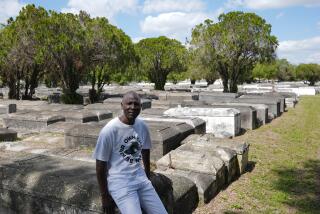Archeologists Find New York a Trove of Treasures
- Share via
NEW YORK — In this ever-changing city, the sight of digging workers usually heralds the coming of a new apartment or office tower.
A few of those poking beneath soil and concrete, however, are not building skyscrapers of the future but seeking stronger connections with the city’s past.
From the farthest reaches of Brooklyn and the Bronx to the city’s green heart in Central Park, urban archeologists are hunting for centuries-old dishware, toys, chamber pots and even the remains of garbage dumps--any bits of history that will add color and detail to New Yorkers’ understanding of the lives of those who came before.
“New York is . . . always concerned with the present and looking to the future,” says Diana Wall, a City College anthropologist who’s taken part in excavations all over the city. Archeology “provides an historical depth to this place.”
Archeologists say their urban work often provides valuable details about the everyday existence of those who didn’t make it into the history books, especially minorities, women, workers and the poor.
In 1991, excavation for a federal office building in lower Manhattan uncovered a cemetery from the 1700s where as many as 20,000 people, mostly slaves and free blacks, are believed interred.
Even before digging began, archeologists suspected the existence of the African Burial Ground, but they were startled by its scale. Historians believe blacks were buried there after nearby Trinity Church said they could no longer be buried on its land.
Under pressure from protesters, the federal government altered its building plans to preserve some of the graveyard and create a memorial, which has since been declared a national historic landmark.
Slightly to the south, in the financial district, workers excavating for an office tower in the 1980s unearthed the remains of a ship from the mid-1700s. It had been scuttled at the end of that century and used as part of a temporary dam before becoming landfill.
And this summer, nine interns supervised by researchers from City College, Barnard College and the New York Historical Society searched Central Park for clues about Seneca Village, a settlement of free blacks and Irish immigrants. They were forced out of the village in 1857 to make way for the park.
Working between 82nd and 89th streets on the park’s west side, the students probed with ground-penetrating radar and instruments that use electrical conductivity and resistivity to find objects underground. They were looking for sites that might yield the remains of basements, wells and garbage dumps, and thus be worth the disruption to the park that excavating would cause.
The interns’ findings are being loaded into computers for analysis by project leaders. Nan Rothschild, a Barnard anthropology professor and one of several researchers involved in the study, says it’s not yet clear what the team has found.
The team hopes buried artifacts will fill gaps in knowledge about Seneca Village, whose residents were long seen as vagabonds and squatters. That view, she says, was useful to those who evicted them but has been discredited by scholars.
Rothschild says tax, church and census records have shown this was a stable community of several hundred people, families who owned land and held jobs.
More to Read
Sign up for Essential California
The most important California stories and recommendations in your inbox every morning.
You may occasionally receive promotional content from the Los Angeles Times.













